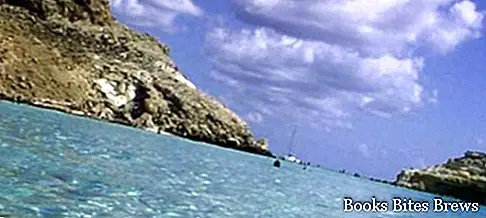What to see in the Pelagie islands, an archipelago located in the Mediterranean, between the Tunisian and Sicilian coasts, made up of the Lampedusa, Linosa and Lampione islands. From a geological point of view, the island of Lampedusa and the islet of Lampione are part of the African continental plate and have a limestone-dolomitic nature, while Linosa belongs to Europe and has a volcanic nature. The archipelago is part of the Pelagie Islands Marine Reserve.
Tourist information
– Lampedusa it is closer to Africa than to Sicily and looks like a rather barren and rocky plateau, whose maximum elevation coincides with the 133 m. tree hill. above sea level, excellent vantage point located on the north western side of the island.
The surface of the planking slopes gently from north west to south east.
The north and north western coast is distinguished by the fascinating high and continuous rocky walls, rich in caves and natural ravines, in front of which the rocks of Sacramento and Vela emerge.
The south and south east coast, lower and more lively, alternates steep headlands with deep inlets that end with enchanting sandy beaches.
The coves that wind along this coast are very beautiful, including Cala Pulcino, a beautiful white sand beach that can be reached by sea or by walking down a difficult cliff path, Rabbit Beach, a famous beach where Caretta Caretta turtles deposit their their eggs, is a protected area that also includes the neighboring island of Rabbits.
Baia della Tabaccara, a large and suggestive inlet with a beautiful turquoise sea, Cala Galera, a beach located in a deep and narrow inlet which continues inland with a valley where there are mulberries, fig trees, in the midst of the characteristic dry stone walls , Cala Madonna, beach where the sea has very beautiful backdrops.
The beach takes its name from the Sanctuary dedicated to Maria S.S. of Porto Salvo located in the inner valley.
Cala Croce, double inlet with two excellent beaches, Cala Guitgia, beautiful and crowded beach, Cala Francese, a small beach with rocks that emerge from the sea, Cala Pisana and Cala Creta, small and quiet beaches with crystal clear sea, Cala Calandra, also called Dead Sea because the sea is always calm, Capo Grecale, is the north eastern end of the island and houses the lighthouse.
On the island there are the typical stone buildings called Dammusi, built in the second half of the nineteenth century, after the colonization by Ferdinando II of Bourbon.
What see
To the north-west of Lampedusa is Lampione, an uninhabited islet without vegetation, surrounded by clear waters, where a lighthouse rises, reachable by boat in about an hour of navigation, sailing from Lampedusa.
Recommended readings- Mazara del Vallo (Sicily): what to see
- Trapani (Sicily): what to see
- Randazzo (Sicily): what to see
- Milazzo (Sicily): what to see
- Sicily: Sunday day trips
– Linosa, of volcanic origin, is made up of ancient craters and volcanic cones that are now extinct.
At the center of the island is the main crater, La Fossa del Cappellano, delimited by the three cones of Mount Vulcano, m. 195, Monte Rosso, 186 m., Monte Nero, 107 m. with its slopes another small crater.
In the only inhabited center of the island, where there is a small port, the typical houses with terrace roofs are white or colored, with doors and windows edged with contrasting color stripes.
The landscape, almost all year round green and flowery, is enriched by the typical Mediterranean scrub and the cultivation of vines and capers.
On the beach of Pozzolana the Caretta Caretta turtles lay their eggs.
In a recovery center, turtles, caught in nets or hooks, are treated and then released to their natural environment.




